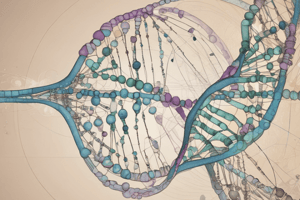Podcast
Questions and Answers
What blood types would be expected in the offspring of a man with type AB blood and a woman with type O blood?
What blood types would be expected in the offspring of a man with type AB blood and a woman with type O blood?
- Type O and AB
- Only type B
- Only type A
- Type A and B (correct)
How many Barr bodies would be expected in mammalian cells with a chromosomal constitution of XXXY?
How many Barr bodies would be expected in mammalian cells with a chromosomal constitution of XXXY?
- 3 (correct)
- 4
- 1
- 2
What is the risk of transmitting a mitochondrial disease from a mother with the disease to her children?
What is the risk of transmitting a mitochondrial disease from a mother with the disease to her children?
- 25% risk
- 100% risk (correct)
- 0% risk
- 50% risk
What is the expected recombination frequency if 100 out of 1000 offspring are recombinants?
What is the expected recombination frequency if 100 out of 1000 offspring are recombinants?
Which process ends the multicellular haploid phase of a plant’s life cycle?
Which process ends the multicellular haploid phase of a plant’s life cycle?
What is the main purpose of meiosis in animals?
What is the main purpose of meiosis in animals?
What incorrect statement describes the role of DNA ligase?
What incorrect statement describes the role of DNA ligase?
What identifies the 3’ end of a DNA strand?
What identifies the 3’ end of a DNA strand?
Flashcards
Blood Type Inheritance
Blood Type Inheritance
A man with type AB blood (I^AI^B) marries a woman with type O blood (ii). The possible blood types in their offspring are type A (I^Ai) and type B (I^Bi), each appearing with a 50% probability.
Barr Bodies
Barr Bodies
Barr bodies are inactive X chromosomes found in female mammalian cells. The number of Barr bodies in a cell is one less than the number of X chromosomes. For instance, a cell with XXXY chromosomes would have 3 Barr bodies.
Mitochondrial Disease Transmission
Mitochondrial Disease Transmission
If the mother has a mitochondrial disease, all her children will inherit the disease, regardless of their father's genotype.
Recombinant Chromosomes
Recombinant Chromosomes
Signup and view all the flashcards
Recombination Frequency
Recombination Frequency
Signup and view all the flashcards
Meiosis in Animals
Meiosis in Animals
Signup and view all the flashcards
Alleles in a Bivalent
Alleles in a Bivalent
Signup and view all the flashcards
Multicellular Haploid Phase in Plants
Multicellular Haploid Phase in Plants
Signup and view all the flashcards
Study Notes
Blood Type Inheritance
- A man with AB blood and a woman with O blood will have offspring with blood types A or B.
Barr Bodies
- Mammalian cells with a XXXXY chromosomal constitution will have 3 Barr bodies.
Mitochondrial Disease Risk
- If one parent has a mitochondrial disease and the other does not, all children will have a risk of inheriting the disease.
Drosophila Gene Location
- The purple (p) and curved (c) genes in Drosophila are on the same chromosome.
Recombinant Chromosomes
- Recombinant chromosomes in the F1 generation are shown in the diagram.
Meiosis Purpose
- Meiosis in animals produces gametes.
Meiosis and Alleles
- A homologous pair of chromosomes in a bivalent will possess four alleles for each locus in meiosis.
Plant Life Cycle End
- Fertilization ends the multicellular haploid phase of a plant's life cycle.
DNA Strand End Identification
- The 3' end of a DNA strand is identified by a free -OH group on the sugar.
Guanine-Adenine Ratio
- If a species has 22% guanine in its genome, it is expected to have 28% adenine.
DNA Ligase Deficiency
- A deficiency in DNA ligase will result in DNA fragments not linking together correctly.
Telomere Function
- Telomeres are repeating DNA sequences at the end of chromosomes that protect and identify them.
Promoter Region Function
- The promoter region is a DNA region where RNA polymerase binds and initiates transcription.
Spliceosome Composition
- Spliceosomes are composed of snRNPs.
Membrane Component Exclusion
- Nucleic acids are not a component of biological membranes.
Membrane Fluidity Factors
- Saturated fatty acid tails, high temperatures, and shorter fatty acid tails increase membrane fluidity, while cholesterol and double bonds in fatty acids decrease it.
Membrane Transport Inhibition
- Iron (Fe+) cannot directly pass through the membrane due to its charge.
Isotonic Solution Red Blood Cell Response
- Red blood cells placed in a 4% NaCl solution (hypertonic) will shrink (crenate).
tRNA Function
- Anticodon is the part of tRNA that interacts with the codon.
Translation Elongation
- Elongation of translation involves moving a peptidyl-tRNA from the A site to the P site.
Membrane Transport Protein Types
- Antiporters transport two or more molecules in opposite directions across the membrane.
Studying That Suits You
Use AI to generate personalized quizzes and flashcards to suit your learning preferences.




